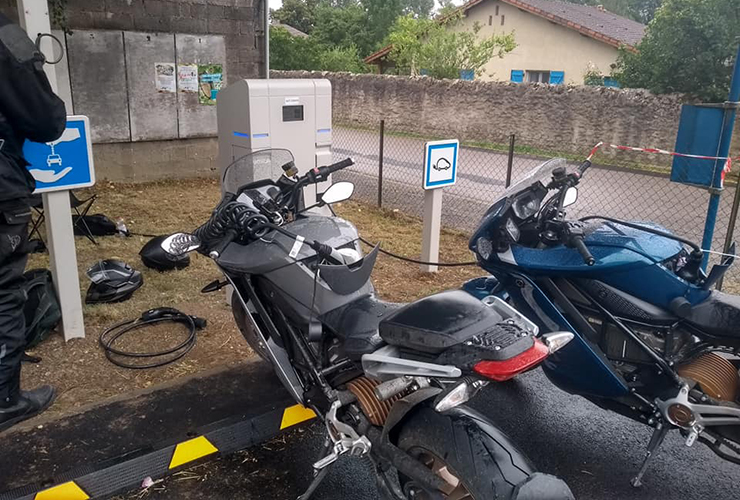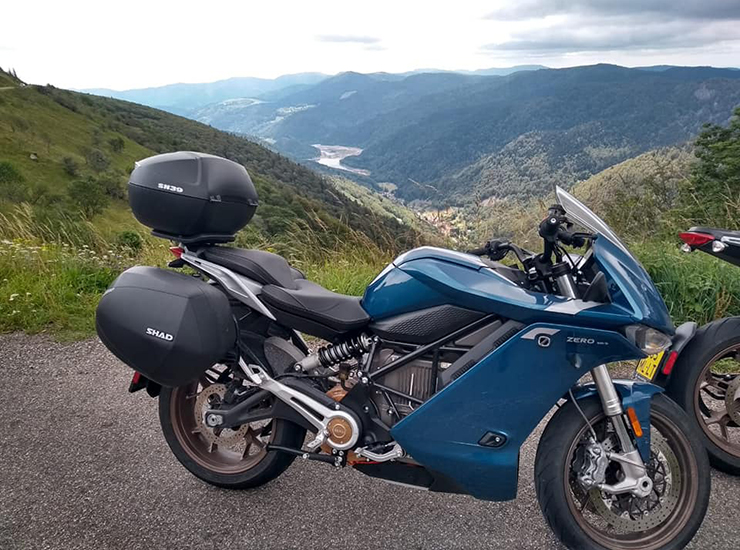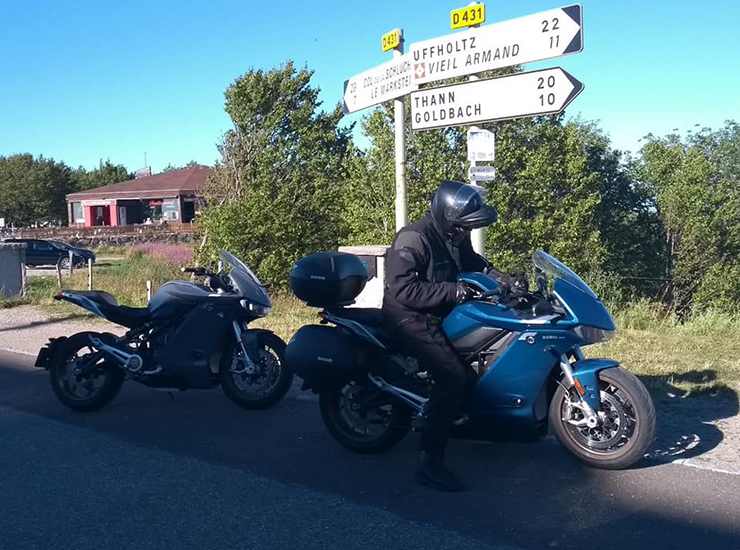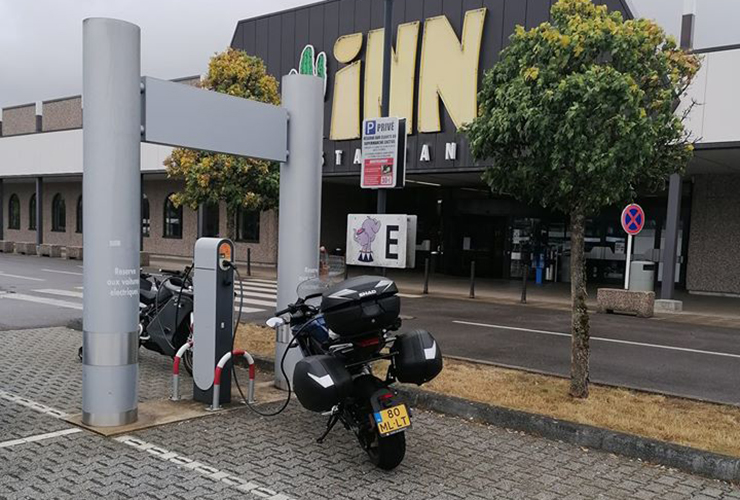Text & pictures: Andrew Thijssen | BMS E-Motorrijder | Driving long distances or going on a holiday with an electric motorcycle? There are believers and non-believers … Is it possible? At THE PACK, we were asking these questions for a long time. Time to check it out. Thx to Guy for arranging 2 Zero SR/S Premium motorcycles with 12 kW AC chargers from Zero Motorcycles Benelux. One Zero has a mounted 3-piece suitcase set from “SHAD” (Curious to see if this would affect our range).


Normally I should have done this trip with Guy (leader of THE PACK, ha ha) but due to a broken ankle this was not such a good idea to let him ride a motorcycle … but I found easily a new companion rider, no problem.
In The Netherlands, we have a pretty good charging station infrastructure. Let’s find out how this works for countries as Belgium, Luxembourg and France. To find these charging stations, we use the widely used Chargemap app. This app is up-to-date and very informative for finding and navigating to charging stations. We decide to ride as many tourist routes as possible and avoid the highways.

Our Zero’s have a 14.4 kWh battery, this allows – when we avoid the motorway – a functional distance of 160-170 km. With the 12 kW chargers, the batteries can be charged from empty to full in over an hour. For 20-80% capacity, it takes 20-30 minutes. The route has been chosen to stop after 120-140 km at a charging point, preferably a 22 kW charger because then the 12 kW charging speed can always be achieved. The choice is made to ride in ECO mode because it provides more than enough power and flexibility. You can always choose a different mode if you want. The blue SR/S with the luggage set is the pack mule of the bunch. The suitcases don’t have enough space for both riders’ belongings and the charging cables. 2 thick type 2 and “Schuko” cables (socket). An extra backpack offers a solution.


The journey to the South is going well, the charging stations we select are without exception easy to find via the navigation on the Chargemap app. Unfortunately, during the first charging session it appears that one of the (blue) Zero’s 12 kW charger set does not work. We are now dependent on the 6 kW charging speed of this motorcycle. Apparently the additionally mounted 6 kW charger is not properly set. That will be 1 hour of charging instead of 30 minutes. Bummer! Well, that is the charm of traveling? Unexpected events, but it shouldn’t actually happen. Sorry, Zero, this was a minus.

The Zeros can be maneuvered with playful ease through the Ardennes thanks to the semi-sporty handling, aided by the flexibility of the gently screeching electric motors. The ascending parts of the route do require some extra energy, but this is partly compensated by the regenerative effect of the engines during descending parts. The ECO mode works fine in this up- and downhill environment. More than enough to perform a quick and silent catch-up sprint, even on the mountain.
After every +/-140 km it is time to stretch our legs again, especially for travel companion Mark with his length of 1.97 meters. Charging points are easy to find in Belgium and France. In France we sometimes find a charging station behind a closed gate of a (car) company because it is weekend. We also learn to select this in the app and avoid these kind of charging points. Because we have to charge longer than expected, we combine that with a snack, a drink or just a chat with a curious person passing-by.


At the end of day 1 we see a “Van der Valk Hotel” close to the highway. This hotel chain is often equipped with (fast) chargers. On that highway, Mark went full power with the SR/S (the one with the suitcases; when he arrives at the hotel, his motorcycle has 4% (9 km) residual capacity against 30% of the other Zero. On arrival the hotel turned out to be fully booked… and only equipped with Tesla Superchargers. We booked another hotel through Booking.com which was located 15 km away in Luxembourg. Fortunately, the remaining number of km is estimated on the basis of the average consumption of the last trip. We drive to the hotel at moderate speed. On arrival we have 6 km left. Unfortunately it was not possible at this hotel to charge at night from a power outlet. So far, the Zero SR/S with the luggage set has consumed about 10% more energy. Opposite the hotel is a supermarket with a 22 kW charger; here we can charge for free, which is common with most supermarket chargers in France. The 6 kW charger gives us some extra time for groceries and the always recurring chat with interested parties.


The journey continues through the Northern French countryside. On the quiet French backroads, a speed limit of 70 km / h applies in most places. We are warned to respect this speed. This is beneficial for the Zero’s energy consumption. That is why we decide to charge the 6 Kw Zero for 80% at the next stop, which shortens the charging time. Due to this lower speed limit, the extra consumption of the Zero with the luggage set drops by up to 5%.
During a rain shower, the top half of the Zero SRS appears to provide little protection for the rider against rainwater. The top half directs the water to the center of the window and blows it against your jacket. Conclusion, as every motorcyclist knows, this results quickly in some wet lower underparts … But the rain map ensures that the power is very gradually applied to the wet asphalt.

In the meantime, the battery of the not fully charged Zero is draining considerably. We decide not to continue until the last “Ampere”. We stop at the next village to find the nearest charging point via the app. We drive into a village and immediately behind the next bend we see a brand new loading place. The charging station is easy to operate and works great. Meanwhile we find out that Mark lost his phone on the way.


With about 80 km to go we can disconnect the motorcycles relatively quickly. We arrive at our destination Gerardmér at the end of the afternoon. The charging station with 2 charging points in the middle of the town is directly opposite a motorcycle-friendly hotel where we check in. This charging facility in Gerardmér is also free. We decide that this place will be our homebase to discover the Vosges. That same evening we hear that the phone has been found by a few cycling Dutch people. These cyclists are staying in Nancy. The next day we decide to head up to Nancy first. A trip of 200 km. We rode to Nancy with empty suitcases. It is striking that the Zero SRS now steers remarkably light-footed. This is mainly due to the suitcases that stick out quite far, making them extra tangible with luggage. We rode back after a charge and then drive the Route de Crêtes, so that day we have done 350 km route national.


Mountain area is ideal for the characteristics of electric motorcycles, instant torque and no need to shift gears. The ECO mode is also more than sufficient for riding the passes. If you still have “Rossi” aspirations you can always opt for a faster mode. In the sportier modes there is less engine brake regeneration, so you have to rely more on the friction brakes. The radial front brakes are fine, the rear brake brakes less well and is insensible.



The suspension and safety systems such as ABS and traction control do their job unobtrusively on the highly variable quality of the Belgian and French roads. The roads in the Vosges are also of an excellent quality. In reality, a trip of 180-200 km in the mountains is quite possible, which means that you can ride in the mountains for a whole day, using a coffee or lunch break as a recharge moment. A lunch is not a punishment in an average French lunchroom. In the Vosges, and the rest of France, you must realise that the use of charging stations and charging cards are not uniform. Furthermore, the instructions for use of the charging posts are almost always in the French language. Difficult if you do not master the language.


A nice side effect with warm weather is the absence of engine heat. This makes driving more pleasant, especially if the speed is a bit lower in a residential area or if you are standing in front of a traffic light. In front of that traffic light you can easily chat with each other because of the absence of the engine noise. Nice parts to drive are the Ballons, the Markstein, route de Crêtes. There are also numerous viewpoints with ample parking space. Be careful that you park the motorcycle on a flat piece, an electric motorcycle has no gear to lock a wheel. Like everywhere you have to look for charging facilities in the cities / villages.



After 2 days in the Vosges we go back home via Route National and a lot wiser with regard to using French, Luxembourg and Belgian charging points. The moment we want to leave, I cannot get the key in the ignition. On closer inspection we see that a tab of the key has broken off. As a result, the key no longer fits in the ignition lock. These Zero’s still have a classic “plug-in / turn” ignition lock, while you would expect a keyless ride on such a modern motorcycle. After contacting the ANWB and visiting the local motorcycle shop, this team does not dare to work on the Zero… unknown technology and danger of destroying more than intended. Also forwarding the ignition lock is not an option, according to Zero. Zero Motorcycles Benelux arranges another Zero SR/S through Zero Motorcycles Germany. This will be brought to our hotel the next morning. Unfortunately, only one SR/S with a 3 kW charger is available. That requires a completely different approach to the return journey…. So now we have to be even more creative and patient with the loading time. Charging a battery from almost empty to almost full takes about 4 hours with the 3 kW charger. Our request to deliver the new Zero SR/S fully loaded has been honoured. We can leave immediately after delivery for the first 150 km. That means that somewhere near Metz we have to make a longer stopover that we combine with lunch.



Google Maps sends us on beautiful winding roads through small villages. This requires little energy from the motors and we make extensive use of the brake regeneration. Loading, eating quietly, the fastest loading engine full, the least loading engine up to 80% … meanwhile, we know how this works. At the end of the afternoon we reach the south of Luxembourg. During a break we arrange a sleeping cabin at a campsite. This cabin will have an electrical outlet where we can charge the engines overnight. When we arrive at the campsite, the sleeping cabin is ready for us and there are some sockets available. The schuko cables are plugged in … and the German 3 kW Zero then does nothing. The other Zero charges just fine. This is tricky. Charging points are not in the area of the campsite. For that we have to go to Esch sur Sure, there are the nearest charging stations. There we meet the only Luxembourg Zero SR/F rider. We immediately have enough material to talk while the motorcycles are loading.

We leave Luxembourg and meander through the Belgian Ardennes. We reach the Netherlands and drive via the beautiful Voeren region to Gulpen in Limburg. In Gulpen we find a charging station in the middle of the village with a lot of cafes and restaurants. But I noticed that it is a charging station from Nuon Vattenfall Heijmans, I have less good experience with that… and my fear is confirmed, it does not work. A call to the helpdesk only results in a friendly talk to a lady who cannot help…. My umpteenth experience with this provider. After dinner we go outside the village to a charging place with 10 charging stations. It is busy there, but there are just two loading places available for both motorcycles. Because the charging stations now all supply power, the Zero’s charge very slowly. At last we arrive at the Gulpener Brewery, which also has some charging points, where we have a drink on a terrace while the engines charge normally. We only have to fill about 90 km … and we continue our journey. We will reach our final destination in the evening. We have estimated the range exactly. Mark arrives at the final destination in “limp mode”.

Conclusion:
The idea of going on a long trip with 2 electric motorcycles was quite a challenge. Too bad that one of the 12 kW chargers was not working. This immediately eliminated the set-up of the tour, namely to be able to cover large distances in a relaxed manner and relatively quickly.
The Zero’s are very nice and comfortable riding motorcycles with good handling and good looks. It is a pity that the spacious luggage set is not mounted tightly against the motorcycle, which is at the expense of the good driving characteristics. The extra energy consumption of 5-10% by this suitcase set is not too bad, we can live with that.

On the backroads, the Zero SR/S is completely in its element, good regeneration, little use of the friction brakes and very comfortable due to the ever-present torque and of course the absence of engine noise and exhaust fumes. Especially nice when you drive behind each other.
We also recommend Zero to take a closer look at the ignition key … that really needs to be changed. It is great that Zero Motorcycles was able to deliver another motorcycle at short notice. Too bad there was only a motorcycle available with the slowest charging charger… and of which the Schuko did not work, so we ran into “long distance prejudices” instead of being able to prove the contrary.


A lot of work is being done everywhere on the charging infrastructure. The charging stations are by no means always located in easy and logical places and do not always work reliably. There is also little uniformity in the operation of these chargers, especially in France. Energy costs are low. Especially because charging is (still) free in many places in Belgium and France. The total charging costs over these 2000 km for both motorcycles amounted to € 45,- for both motorcycles together… these are cheap travel costs!
We have not been able to demonstrate the goal of quickly covering a great distance with an electric motorcycle. You can also cover a great distance with slow-charging electric motorcycles. You have to be creative with the time and above all not in a hurry…. If you can, it is a form of slowing down. You should not use an electric motorcycle for highway rides at this time. Let’s face it, motorcycling is the most fun on backroads and the vacation always starts at home.